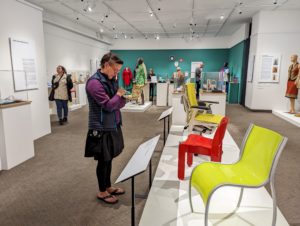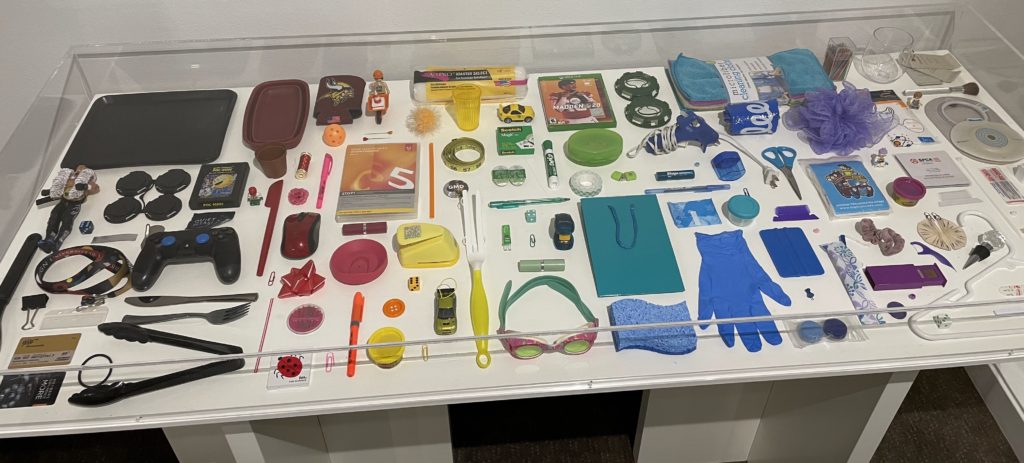by Julie Moore and Kris Kunz
This past November, Freshwater invited Minnesota Water Stewards to visit an exhibit at the Goldstein Gallery on the St. Paul campus of the University of Minnesota — “Plastic Rapt: A History of Designing Forever.” The group toured the exhibition and spent time afterwards sharing reactions and information.
The exhibit began with a chronology of the development of plastics, initially created to mimic and replace natural materials. In 1869, the first plastic, celluloid, won a competition as a substitute for the ivory used to make billiard balls. Thirty-eight years later, in 1907, Bakelite was created as a substitute for ivory, jade, amber, and other natural substances in jewelry and cookware handles. This plastic can still be found today in collectibles. A flurry of plastics were developed between WWI and WWII: PVC, for plumbing; Neoprene, a rubber substitute; Melamine, a furniture veneer; Lucite/Plexiglas; polystyrene; nylon; fiberglass; and PET, now used in Mylar and beverage bottles. In WWII, these plastics, particularly nylon, played a key role in military equipment as a substitute for silk in parachutes as well as other applications. The expansion of plastic usage in WWII increased the pace of plastic development in the following years, adding Polyester (Dacron), Polyethene (PE), ABS, polypropylene (PP), spandex (Lycra), and Kevlar.
 The exhibit featured spectacular pieces of clothing made from polyester, patent leather, fake suede, and wicking fabrics—all of which are really plastics. Although these fabrics are definitely beautiful and useful, they do have a down side. As they are worn and cleaned, “plastic fabrics” shed microplastic particles which end up in wastewater facilities. In addition, as plastic building materials and other outdoor uses of plastics wear down or are burned, microplastics are shed into the environment and deposited into the soil or airborne. Plastic trash that ends up in waterways and the ocean gets ground into smaller and smaller particles, some of which are ingested by fish and other aquatic inhabitants. Although humans to do not purposely eat plastic, we take it into our bodies in many ways, including directly from plastic beverage bottles, cookware coatings, dishes, and plastic ware.
The exhibit featured spectacular pieces of clothing made from polyester, patent leather, fake suede, and wicking fabrics—all of which are really plastics. Although these fabrics are definitely beautiful and useful, they do have a down side. As they are worn and cleaned, “plastic fabrics” shed microplastic particles which end up in wastewater facilities. In addition, as plastic building materials and other outdoor uses of plastics wear down or are burned, microplastics are shed into the environment and deposited into the soil or airborne. Plastic trash that ends up in waterways and the ocean gets ground into smaller and smaller particles, some of which are ingested by fish and other aquatic inhabitants. Although humans to do not purposely eat plastic, we take it into our bodies in many ways, including directly from plastic beverage bottles, cookware coatings, dishes, and plastic ware.
One particularly impressive display showcased a rainbow of small household and personal items made of colorful plastic, a reminder of how indispensable plastic is in our everyday lives and has been for decades.
The exhibit suggested ways we can reduce the prevalence of plastics and their ill effects in the world through recycling, reusing, and purchasing items made of natural materials or recycled/reused materials. It also reviewed some of the promising research into alternatives to plastics, such as “leather” made from prickly pears, a fabric made from mushrooms, and fabric and home furnishings made from discarded pineapple leaves.
In a discussion following the exhibit, the stewards shared their personal efforts to reduce the proliferation of plastics and their effects and discussed future tours and events. A tour of a wastewater facility is high on the list. If you have suggestions, please share them with Freshwater.
